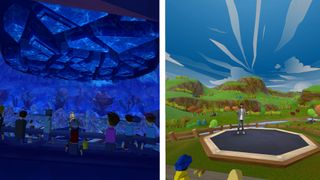Microsoft Mesh is a holographic communication platform straight from science fiction
Microsoft has shared its vision for the future of communication and collaboration

Microsoft announced last month that the keynote for its annual Ignite conference would be a little different this year, but the company gave little warning of quite how different.
Held over virtual reality platform AltspaceVR, the event offered a glimpse into Microsoft’s vision for the future of communication that was as nightmarish as it was compelling.
The event showcased everything that is terrible about extended reality (XR), from technical mishaps to gimmicky set pieces. But it was also a reminder, as video conferencing fatigue reaches new heights, that we’re just at the start of the remote collaboration revolution.
- Here's our list of the best virtual events platforms right now
- Check out our list of the best project management software around
- We've built a list of the best productivity software available
If Microsoft CEO Satya Nadella is to be believed, the “interweaving of digital bits and physical atoms” will make communicating from afar an entirely different proposition in years to come.



Microsoft Mesh
The keynote’s headline announcement was the arrival of a new mixed reality platform, called Microsoft Mesh, that Nadella says will make remote communication feel more intimate and less uncanny.
“Mesh enables you to interact holographically with others with true presence, in a natural way,” he explained.
“I could join a birthday celebration with my extended family in India, interacting as if we were physically together, without any screens between us. Or I could meet my colleagues on the other side of the world and collaborate as though we were in the same room.”
Are you a pro? Subscribe to our newsletter
Sign up to the TechRadar Pro newsletter to get all the top news, opinion, features and guidance your business needs to succeed!
Powered by the compute and AI capabilities of Azure, Mesh is also designed to allow designers and engineers that handle 3D models to work together across continents in a way that has never before been possible.
“Microsoft Mesh connects the physical and digital worlds, allowing us to transcend the traditional boundaries of space and time,” said a holographic version of Alex Kipman, Technical Fellow at Microsoft.
“This has been the dream for mixed reality, the idea from the very beginning. You can actually feel like you’re in the same place with someone sharing content or you can teleport from different mixed reality devices and be present with people when you’re not physically together.”
Initially, Mesh users will only be able to appear as avatars, but Microsoft has promised that “holoportation” will eventually allow people to communicate as photorealistic forms of themselves.
The announcement might send a shiver down the spine of anyone hoping for a return to the office of old, but for others it’s a window into a future imagined only in science fiction.
- Working from home: the mouse, monitor, keyboard and router you need

Joel Khalili is the News and Features Editor at TechRadar Pro, covering cybersecurity, data privacy, cloud, AI, blockchain, internet infrastructure, 5G, data storage and computing. He's responsible for curating our news content, as well as commissioning and producing features on the technologies that are transforming the way the world does business.